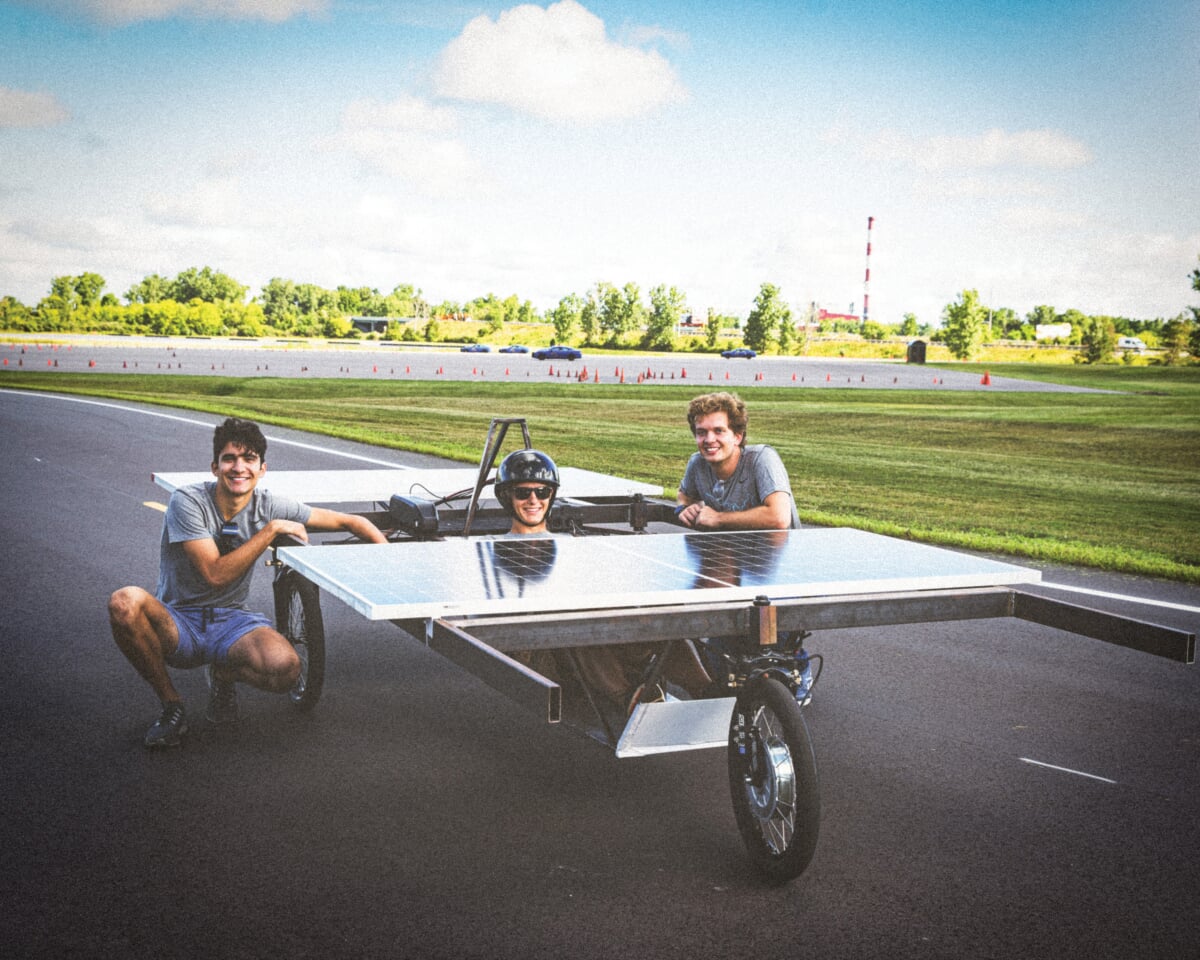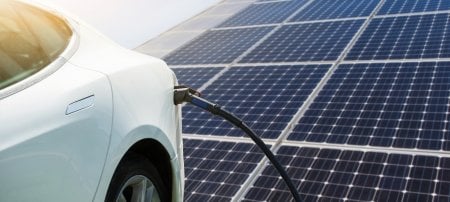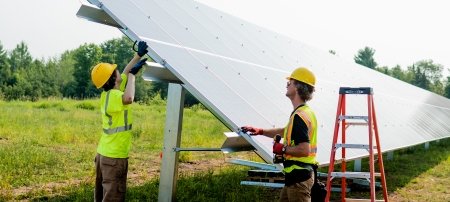A group of engineering students spent years chasing a shared dream: to complete the first coast-to-coast American road trip fully powered by the sun. What could possibly go wrong?
Even on a sunny day in June, there are few more unspectacular places in America for a dream road trip to limp to an end than the Holiday Inn parking lot in Logansport, Indiana. This is especially true—and the sunshine especially ironic—when you're driving a homemade solar car, attempting to complete the first solar-powered trip across America.
So it was for Kyle Samluk '24, Danny Ezzo '25, and Will Jones in the summer of 2021. The friends had spent nearly a year dreaming up, designing, and building what they hoped would be the first car fully powered by sunlight to complete the infamous cross-country road race known as the Cannonball Run. Conceived in 1971 by late Car and Driver editor Brock Yates and popularized in a series of Hollywood films in the 1970s and early '80s starring Burt Reynolds, the renegade road race between New York and Los Angeles has since evolved into a self-guided contest of dodging police and suppressing bowel movements using military-grade tactical dehydration pills while averaging speeds well above any speed limit in America.
"We're car guys, so early on during the pandemic, we started seeing reports and tales of people breaking Cannonball Run speed records, because there was no traffic," Will says. "So we had the idea of doing a Cannonball Run in a solar car. It seemed like sort of a safe, legal way to participate in this outlaw event. We thought it might inspire people to get more interested in solar power and other alternative energy sources. Plus, no one had ever driven a solar car from New York to Los Angeles. It seemed like an epic adventure and an epic challenge."
While the rest of the world was doomscrolling and Netflixing their way through Thanksgiving break of 2020, the three friends were maxing out the monthly Wi-Fi data at Will's parents' house during a marathon computer-aided drafting session. Once they had their design sussed out, they holed up in a shop in DeWitt, Michigan, and got to work. The shop belonged to Russ Pline, Kyle and Will's math teacher at Okemos High School, from which they had graduated in 2019. Prior to housing the solar car, Pline used the space to restore vintage hot rods and campers from the 1930s.
"Just before spring break, I get a call from the guys, and they say they have an idea," Pline recalls. "So we go out to lunch, and they've already designed the car. I could tell it had some shortcomings. The design—an aluminum monocoque body setup, good execution of a design—showed they lacked some experience. But there's also just no substitute for experience. I said, 'You guys are trying to do something big here. Shame on me if I don't help you.'"
With Pline's assistance, the trio built the car in a hurry and gave it a name to match their rose-colored optimism: Pink Skies. It looked like a cross between a ping-pong table and a hovercraft—and during the car's first test run, it performed more like the former than the latter. The aluminum frame on which the solar panels were mounted was sturdy but heavy, as were the three ill-positioned motorcycle tires supporting the frame. One of the few components that did not show clear room for improvement was the maximum power point tracker, or MPPT—the electrical device responsible for converting DC power from the solar panels and delivering it to the battery powering the motor. The same MPPT had been among the best-performing elements of the first solar car that Kyle and Will had built together in high school. That car had come in second place at the annual Solar Car Challenge, an international competition for high schoolers held at Texas Motor Speedway. Pink Skies, however, gave up the ghost after a mere five miles on the test track.
With only a month left to fix major suspension issues and rebuild the entire front end of the car, the guys dove back into work. They were ambitious and enthusiastic, but their self-imposed start date of June 24 forced them to rush. They cut some corners but managed to make all the necessary repairs just in time, then tossed all the tools and spare parts they owned into the trailer and headed to New York.
"We tried to plan for everything, but at that point we had no experience with doing something crazy like that," Danny says. "But nobody else did either. There was nothing really to learn from. So we were cautiously optimistic."
On June 24, the Pink Skies team set out from the Red Ball Garage in Manhattan. By the time they reached the Lincoln Tunnel, cautious optimism had given way to pure stress. New York City drivers were none too thrilled to be stuck in traffic behind the Jetsons' recumbent tricycle, which cruised at speeds between 25 and 30 miles per hour.
Once out of the city, the team settled into something like a rhythm, inching their way across the highways of New York, Pennsylvania, and Ohio. Along the way, while struggling to service Pink Skies during its many roadside breakdowns, they longed for the shelter and well-stocked tool selection of Pline's shop. By the time they crossed into Indiana—where they spent two full days dodging thunderstorms, fretting as a few essential electrical components got wet from the rain—morale was bottoming out.
Then, the death knell: In Logansport, the motor controller failed.
The team had no backup motor controller with them. Even if they had, they lacked many of the technical skills needed to install one on the fly. They shuffled the car into the parking lot at the Holiday Inn and considered what to do. Pink Skies had made it some 760 miles, but the team was still more than 2,000 miles from the finish line at the Portofino Hotel in Redondo Beach.
With the remaining distance dragging their dreams down into cold, hard reality, they made the call to scrap the attempt.
"That was pretty devastating," says Kyle. "You spend countless hours working, only to achieve nothing, right?"
Crestfallen, they pushed the banged-up solar car into the trailer, strapped it in, closed the door, and headed north—back to Michigan. The ride home was spent in brooding silence. When they got back to DeWitt, the three friends went their separate ways and took a few weeks to lick their proverbial wounds. They reflected on all that had gone wrong. They thought about how they could have prepared better. And they considered, each in his own way, the question that eventually faces anyone who dares to chase a dream, only to come up well short of making it a reality:
Again?
Erwin George "Cannon Ball" Baker was a vaudeville performer turned motorcycle and automobile enthusiast who raced his way to fame in the early 20th century. Baker made dozens of record-setting speed runs across America, during which he was paid to promote Indian motorcycles, Cadillac roadsters, and the other vehicles he drove. Baker set dozens of driving records from the 1910s through the 1930s, including the automobile record from Los Angeles to New York City, which he first set in 1915 in a Stutz Bearcat over 11 days, seven hours, and 15 minutes. "No record, no money" was Baker's bold promise to the companies who sponsored him. It was this audacity that inspired Yates to name the Cannonball Run after Baker, partially as a kind of gonzo protest against the strict traffic laws of the 1970s.
In 2013, nearly a hundred years after Baker's Bearcat rolled into New York City in an unthinkably fast 11 days, a team led by YouTuber Ed Bolian set a new Cannonball Run record in a modified 2004 Mercedes-Benz CL55 AMG: 28 hours and 50 minutes. Six years later, during the early COVID traffic lull, a driving team led by Arne Toman and Doug Tabbutt lowered the record to 25 hours and 39 minutes, driving a modified 2016 Audi S6 disguised to look like a Ford Taurus police interceptor and affectionately dubbed the Fraud Taurus. Bolian averaged 98 mph during his run and hit a top speed of 182 mph. Toman and Tabbutt never went above 175 mph, but they averaged a blistering 110 mph.
Danny knows these names and numbers by heart. Bolian, Tabbutt, Toman, and other motorheads of the YouTube era have been idols of his since he first got interested in cars at age 14. The Cannonball bug bit Kyle and Will a bit later but no less fiercely. After taking some time to reflect on their first attempt, they made a decision in step with all those who dive headlong into such adventures for the sake of, well, adventure: They decided to keep their dream of making the first and fastest solar-powered Cannonball Run alive.
"We took some time off and debated on what the next step should be: build a new car or try to repair Pink Skies," says Kyle. "It probably took us six months to come to a final decision. Ultimately, we decided to redesign from scratch."
Nothing was sacred and nearly everything was up for consideration—the chassis, the suspension, the motors, the solar array—everything. While budget constraints prevented the guys from using carbon fiber for the frame or flexible solar panels for power generation, they made other smart design tweaks toward improving the solar car's serviceability, efficiency, heat management, and weight—like swapping the motorcycle tires for bicycle tires. Modifications like these added up, then multiplied, as the lighter car then required a smaller, lighter battery pack to power it.
"The first car was really hard to work on and it was really, really heavy," says Kyle. "We took our time deliberating when designing the next one."
They even gave attention to the support trailer, stocking it with replacement forks, extra motors, extra bicycle tires, and plenty of tubes, plus all the necessary tools for repair stored in easy-to-access locations.
"On the first trip there was plenty of stuff in the trailer that we didn't use," says Danny. "We just kind of threw it all in. The next time around, we were very intentional. Everything we put in the trailer had a purpose."
The only problem—or challenge, depending on your approach to life—was that Danny, Kyle, and Will were not brand-sponsored road racers or YouTubers. They were full-time engineering students—Kyle and Danny at Michigan Tech, some 500 miles away from Pline's shop in DeWitt, and Will at the University of Michigan-Ann Arbor. (For their second attempt, the team also decided to add a fourth driver: Brett Cesar, a friend of Kyle and Will's from high school and an engineering student at Michigan State.) Kyle and Danny were also varsity student-athletes on the Michigan Tech cross-country team, meaning their free time was limited and precious.
For the next two and half years, they chose to devote nearly every second of it to chasing their solar car dreams. They spent most nights and weekends, along with every holiday break, not with their families or friends or girlfriends, but with Pline in his shop.
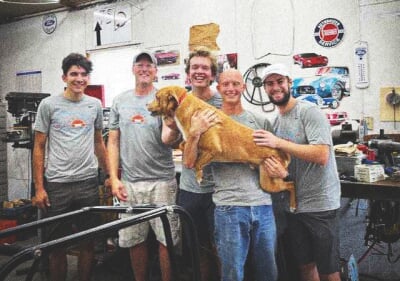
"It's sort of rare at our stage in life to be able to just drop real life for a while and build a solar car," says Will. "We could all be working internships or jobs, but every Thanksgiving, every Christmas break, every free minute over the summer where it was possible, we were in the garage working on this car. In the winter, it would be 20 degrees outside and 23 degrees in the shop. We'd be freezing our tails off. Just shows how passionate we were, and how committed."
Long winter days of wrenching on the car in the unheated shop were broken up with well-earned meals prepared by Pline's wife Vicki, or at the nearby South Riley Grocery, Tavern & Grill—one of those unassuming rural Michigan hideouts whose owners know that pretty-looking signage is far less important than burgers that taste good.
"When Vicki would make us all lunch, these guys would do their own dishes," Pline says. "Clean up after themselves, take the trash out, clean up the kitchen, clean up the shop. These seem like little things, but they are big things that show just how thoughtful these young guys are. Just phenomenal people."
In late June of 2024—six years after Will first came to Pline with the idea for the high school solar car, and three years after Pink Skies' journey ended in Indiana—the team's next build was complete. Christened the Sun Strider, the new solar car featured a budget-conscious frame made of square steel tubing; eight hinged solar panels, which could be propped up for improved serviceability and charging; three bicycle motocross (or BMX) tires; 3D-printed nose and tail cones; and one aerodynamic polycarbonate dome topping the cockpit. Weighing in at a lean 590 pounds, the Sun Strider was ready for the open road. The last thing the guys did at Pline's shop was finish building out the workbench for the trailer, double-checking to make sure it was stocked with everything they'd need and nothing they didn't.
"There was a moment there where I said to them, 'Okay, what else?'" Pline recalls. "And Kyle said, 'I think that's it. I think we're good.' And that's when it hit me. I thought, 'Oh, I think this really is it. This is the end of an era. I don't think these guys are ever coming back.'"
Pline, along with many of the team's family members and friends—and a surprisingly large media contingent covering the automotive industry and Michigan's Lower Peninsula—planned to follow online as the team progressed on their cross-country journey, which they had begun calling the Cannonball Sun. Pline didn't think he would catch the conclusion of the journey, though. The same week in August when the guys were expecting the Sun Strider to roll into California, Pline was scheduled to be running a car at Bonneville Speed Week in Utah. So, in July, just before the team headed east to New York, he met them at Will's dad's house in Haslett, where he gave them hugs, encouragement, road snacks, and a bottle of champagne.
"I told them, 'You guys are gonna need this at the Portofino.'"
Day 1: The Sun Strider rolled out of the Red Ball Garage on July 8 at 4:21 a.m., rolling through midtown Manhattan in full darkness on a fully charged battery thanks to sunshine the day before. The guys quickly encountered poor road conditions, limited visibility, and, even in pre-dawn, significant traffic—with many gawkers slowing down to record phone videos of the Sun Strider in action. The car made it through New York problem-free, though—and, feeling optimistic, the team swapped drivers for a long day ahead.
They got their first flat tire in New Jersey, less than a hundred miles into their 3,000-mile journey. Danny replaced the tube quickly, and the Sun Strider rolled on. In Pennsylvania, a motor wire began rubbing against one of the tires, but the guys caught the problem during another driver switch, before it caused any major issues. Late in the day, near Mifflinburg, Pennsylvania, a rainstorm swept in and forced them to take shelter for an hour beside a friendly farmer's barn. About two miles after getting back on the road, they got their second flat. They spent the precious late-afternoon hours of low-angled sunlight dodging storms and making tire repairs, meaning the car's batteries wouldn't get an evening solar charge.
But they had climbed through a good stretch of the Appalachian Mountains without the car overheating, and they had made it 77 miles farther than they had on their first driving day in 2021, setting two new single-day records along the way: 246 miles traveled and over 16,000 feet of elevation gained.
The next day began a pattern the team would follow for the next dozen: wake up 30 to 45 minutes before sunrise, find a clear spot, and tilt the solar array perpendicular to the low-hanging morning sun. As the car charged, the guys powered up at the continental breakfast bar in their hotel while assessing the weather forecasts and plotting their course. To avoid another weather system on Day 2, they stayed in the Appalachians, heading toward Wheeling, West Virginia, climbing another 16,300 feet and fixing one flat tire over 206 miles. Day 3 greeted them with persistent rain and wind gusts of up to 42 mph. They made it into Ohio, but only covered 106 miles. Day 4 was sunnier and the roads were more level, allowing them to collect 8.1 kilowatt-hours of energy and to drop from three motors to two (all-wheel drive to rear-wheel drive). They topped 40 mph for extended periods of time and covered 186 miles, ending the day with more energy than they began with, in battery and in spirit.
They began Day 5 in Portland, Indiana, just southeast of where their 2021 Cannonball Run attempt ended. Not long into the day, two spokes broke on a tire, causing an issue with one of the Sun Strider's motors. This time around, the team was prepared. They swapped out the motor, replaced the broken spokes, and even bled the right brake, removing some air that had gotten trapped in the system. They breezed through the rest of Indiana, coasting past the 1,000-mile mark for the trip and into Springfield, Illinois, for the night.
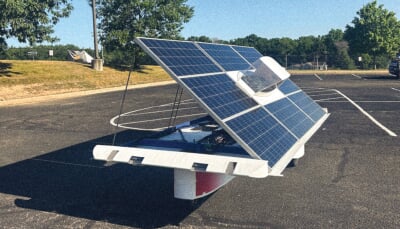
The next week of travel across the Great Plains brought blazing summer sun and triple-digit temperatures, which turned the clear-domed cockpit of the Sun Strider into a sweltering greenhouse. They switched drivers every hour and wore vests soaked in ice water to keep cool. In their pursuit of the solar speed record, they also learned to navigate one particular surprise that no traditional Cannonball Run team had to deal with: a steady stream of curious observers, including a few police officers.
"Along the drive there were a lot of interested people who would come up to us when we were pulled over charging," Danny says. "To keep the ball rolling, sometimes we'd have to have one person talk to the person to distract them, so the other guys could go to the truck and eat or get some water or use the bathroom. Our code word for that was checking the tire pressure on the trailer. So we'd go and take a knee and, um, 'check the tire pressure.' Every once in a while you'd need to double-check the tire pressure. That required a separate set of facilities."
The searing temperatures also strained the Sun Strider's motors and other systems, forcing them to replace more flat tires, broken spokes, motors, and even the car's entire front and rear suspension outside of Salina, Kansas. On Day 11, in Santa Rosa, New Mexico, one of the car's axles got stuck in a motor assembly. There was no simple way to remove the axle, which created a complication: The team would have no way to fix a flat, were they to continue on. They were in a bind—one that would have ended their trip in 2021.
"There's maybe 12 parking spots in the whole town, and we've got 10 of them trying to figure out what to do," recalls Brett. "It was really a low point, morale-wise. Everybody was feeling down. Being the new guy on this trip, I thought to myself, 'Oh, right here is where this trip ends.'"

This time, though, the team had brought with them a reserve supply of ingenuity—and a MIG welder. Sprawled out on baking-hot asphalt in downtown Santa Rosa, they welded a screw extractor onto the axle—a creative solution that allowed them to get the axle out, replace the broken parts, and get back on the road.
The next day as they crossed Arizona, the heat got so bad that the car's nose cone melted, losing its shape. But the blazing sun also meant they were converting solar energy into road miles, not stopping to dodge storms, and covering close to 300 miles a day. Making the finish line now felt not just possible, but inevitable. On Day 13, they sent word ahead to their families, some of whom had flown to Los Angeles to be there for the team's grand arrival at the finish line, to start icing down the celebratory beers.
The summer before, a guy in a 6.4-kilowatt-hour solar-powered Tesla had beaten them to the mark and become the first to complete a solar Cannonball Run, covering some 2,800 miles in 57 days. A year later, in a self-built solar car of their own design and fabrication, they were poised to shatter his record by nearly six weeks.
Then, 188 miles from the Portofino Hotel, while driving in the middle of the Mojave Desert, Brett looked down at the control screen to check the charge. The screen was blank. The Sun Strider had suddenly stopped generating power. He pulled the solar car over on the side of the highway near Desert Center, California. In heat measuring 116 degrees Fahrenheit, Danny and Will shimmied under the solar car to diagnose the issue. Their fears confirmed, they slid back out and reported the bad news: The MPPT had failed.
The internal fans used to cool the MPPT simply could not contend with the July desert heat. As it overheated, its plastic components started to weep, leading to the component's demise. The battery was fully charged, and the car could still drive, but the critical connection between the solar array and the rest of the car was gone—and they had too many miles left to travel on battery power alone.
Fortunately, the guys had brought along an extra MPPT in the support trailer. But it would take an hour and a half to make the swap. They were five hours of driving and charging away from being able to coast through Los Angeles to the Portofino—but there was no guarantee that the replacement MPPT would last through another five hours in the desert heat.
If, as Emily Dickinson said, hope is the thing with feathers, then the Sun Strider team in Desert Center was Icarus in flight. Their waxen wings melting, the team faced a pivotal choice—one that felt strangely like deja vu. In the shimmering heat waves rising from the asphalt, a mirage appeared: the Holiday Inn parking lot in Logansport, Indiana.
Facing such a predicament, most teams do one of two things: implode or explode. The Cannonball Sun team did neither. Instead, they did the same thing they had done after their first Cannonball Run attempt ended, and the same thing they had done for every flat tire and broken spoke and jammed axle for the last 3,000 miles: They regrouped, then put all their energy into attacking the problem at hand.
"We all get tunnel vision toward the issue. We don't really get mad at each other, ever," says Danny. "We've seen some pretty horrible situations together, and we just focus on the issue and get straight to finding the root cause and the solution. I think we all did a really good job of making it 'us versus the problem,' not us against one another."
Working together, they replaced the MPPT, fueled themselves up on water and Uncrustables for the final stretch, and got back on the road. The temperature outside hit 118 degrees. The temperature in the cockpit: 128. The replacement part emitted a persistent high-pitched screech, like a jet engine spooling up, but they had no choice but to limp it along as far as it would last—and for as long as they could endure their half-hour driving shifts.
One mile marker at a time, the Sun Strider motored through the last leg of the journey. Through Cactus City and the Coachella Valley. Through the Moreno Valley and Riverside. Along the Santa Ana River into Orange Hills and Anaheim. And, at last, into the southern reaches of LA and into Redondo Beach.
Finally, at 4:42 p.m. Pacific Standard Time, exactly 13 days, 15 hours, and 21 minutes after pulling out of the Red Ball Garage in downtown Manhattan, the Sun Strider rolled into the parking lot at the Portofino Hotel—and the guys received a heroes' welcome.
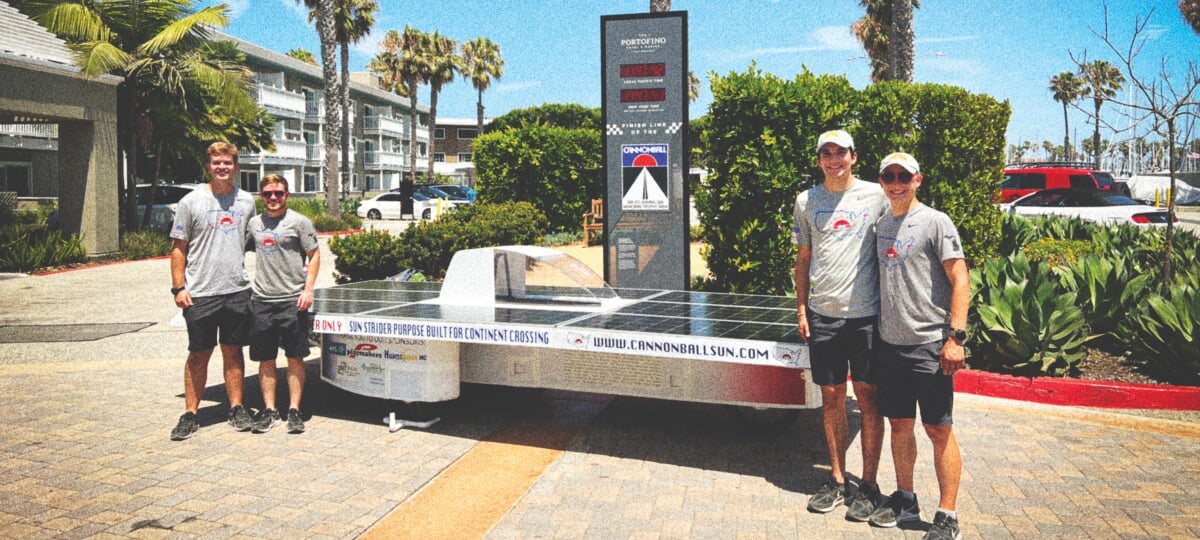
Mothers, fathers, girlfriends, reporters from Car and Driver and other magazines, others who had donated time or money to the cause, and those who had sacrificed quality time with the guys so they could spend another weekend or another holiday building out the solar car and chasing their dreams: They were all there waiting for the team when they arrived.
Even Pline, despite his prior commitment, was there. The car he was supposed to drive at Bonneville got pulled out of the race at the last minute, so he rerouted his flight to Los Angeles and made it just in time for the celebratory spray of champagne.
Will's mother, Jen, recorded post-race interviews with the guys to capture their mood for posterity. To the question of what other people might learn from their journey, Brett said he hoped their solar-powered Cannonball Run would inspire others to dream big and to go after their dreams. Will and Danny joked that they hoped others would learn to install air conditioning in their solar cars. Kyle said it's important to strike the balance of thoughtfulness and gumption.
"Learning the hard way is essential," he says. "You kind of fail forward in a way. We succeeded in this attempt because we took our time and were more intentional about everything. But let's say we had spent an extra three years just working on the first car without making an attempt. I don't think we ever would have completed a Cannonball Run. All the mistakes we made that first trip—we kind of had to do that to be successful this time around. You can't know what you can't know, right?"
To Jen's final question, Kyle gave a reply that would have made Cannonball Run founder Brock Yates proud—and one that perfectly encapsulated the team's relief at the culmination of their grand adventure.
"So, Kyle," she asked the recent Michigan Tech grad—who, earlier in the year, had received and accepted a job offer from Ford Motor Company. "Where do you go from here?"
"Well, from here," he said, "I think we go to the bar."
After hauling the Sun Strider back to Michigan, the team went their separate ways. Kyle and Brett started jobs, and Will and Danny returned to college for their final year of classes. Two months later, in mid-September, they reunited in Haslett for one last adventure. They had been invited to a car show in Minerva, Ohio, featuring Ferraris, Lamborghinis, and, among other drool-worthy cars, Ed Bolian's 2004 Mercedes-Benz CL55 AMG, Arne Toman and Doug Tabbutt's infamous Fraud Taurus, and other record-setting vehicles from the last century of Cannonball Runs.
They were among the first to arrive. From the back end of their big, rusty trailer, they rolled out the scuffed-up, battle-hardened Sun Strider for a crowd of devoted motorheads to behold. Among other imperfections, the car's nose cone had gotten banged up in the trailer on the drive down to Minerva. They soon realized just how different their car was from the others coming to the show.
"Someone pulls up next to us with a trailer that's worth more than our car and trailer combined, then rolls a Lamborghini out of it," Kyle recalls. "Yeah, you could say we felt like imposters."
"People are pulling out their polish," says Will, "and we're pulling out the duct tape."
Among all the Cannonball Sun team members, Danny felt the most nervous about attending the show, standing shoulder-to-shoulder with his idols. His anxiety peaked when Bolian strolled up to the Sun Strider to look it over.
Danny asked him, "Well, is it as homemade as you thought it'd be?"
Bolian walked the length of the car, nodding his head and grinning. "You know," he said, "it's exactly as homemade as I hoped it would be."
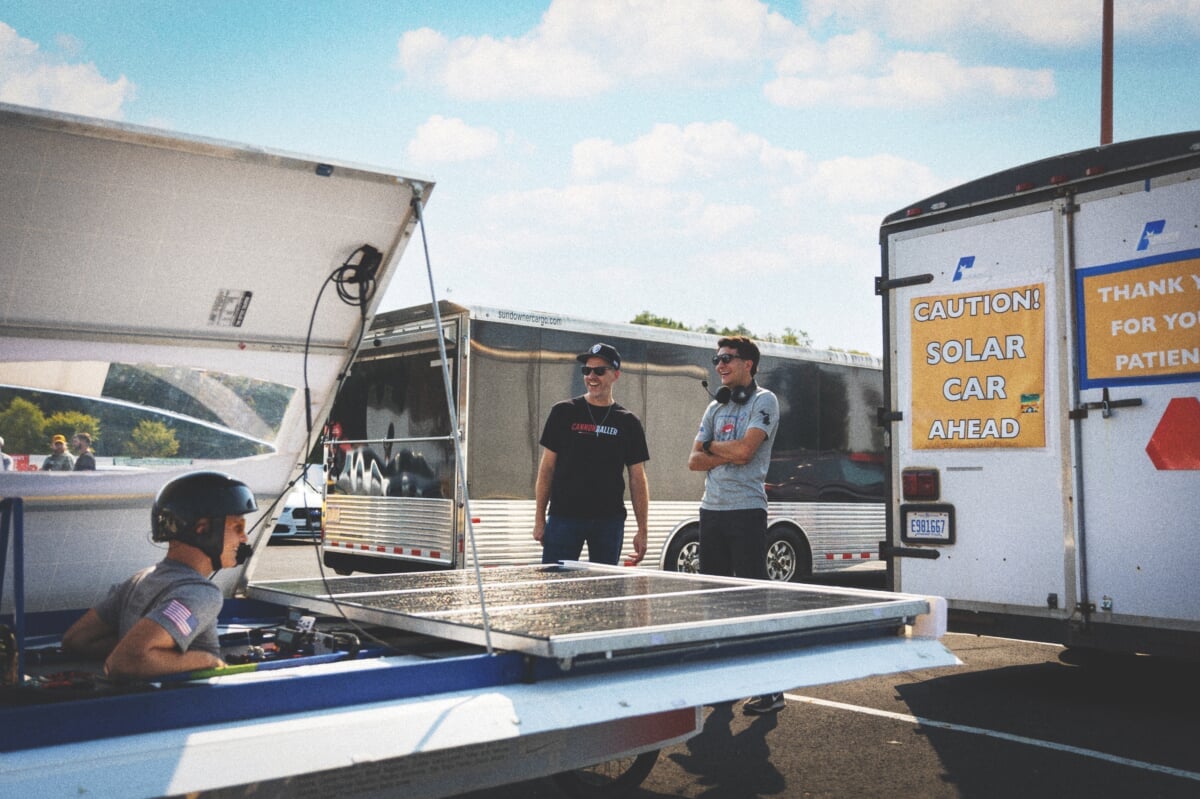
That afternoon, to wrap up the car show, Tabbutt moderated a panel discussion featuring A-list Cannonball Run legends including Bolian, Toman, Brock Yates' widow Pam, and more. Having seen the interest the Sun Strider generated at the car show, Tabbutt decided to invite Danny up on stage to join them. His story about checking and double-checking the tire pressure on the trailer earned some of the biggest laughs of the day.
"I don't think there was a single person at the car show that respected us any less than the other people there," Danny says. "If anything, they respected us more just seeing that our car is homemade, and how different it was from all the other cars there."
The wellspring for that respect traces all the way back to Cannon Ball Baker and his pioneering journey in a Stutz Bearcat. Like the Cannonball Sun team, Baker proved that something people thought was impossible could actually be done.
"In the early days of automobiles, when the infrastructure wasn't what it is now, to claim that you could drive a car across the country was a hot take," Will says. "You drove cars downtown to have dinner or go to the grocery store, not from New York to Los Angeles. People were recently thinking the same thing about solar cars."
Well, not anymore—all thanks to four young engineers from Michigan, the beating heart of American automotive innovation.
"Somebody came up to us at the car show and flat-out looked us in the eyes and said, 'I'm gonna beat your record,'" Danny says. "I was like, 'All right, man, we're here for it. We'd love to see it. That was so much work.'"
Michigan Technological University is an R1 public research university founded in 1885 in Houghton, and is home to nearly 7,500 students from more than 60 countries around the world. Consistently ranked among the best universities in the country for return on investment, Michigan's flagship technological university offers more than 120 undergraduate and graduate degree programs in science and technology, engineering, computing, forestry, business, health professions, humanities, mathematics, social sciences, and the arts. The rural campus is situated just miles from Lake Superior in Michigan's Upper Peninsula, offering year-round opportunities for outdoor adventure.

